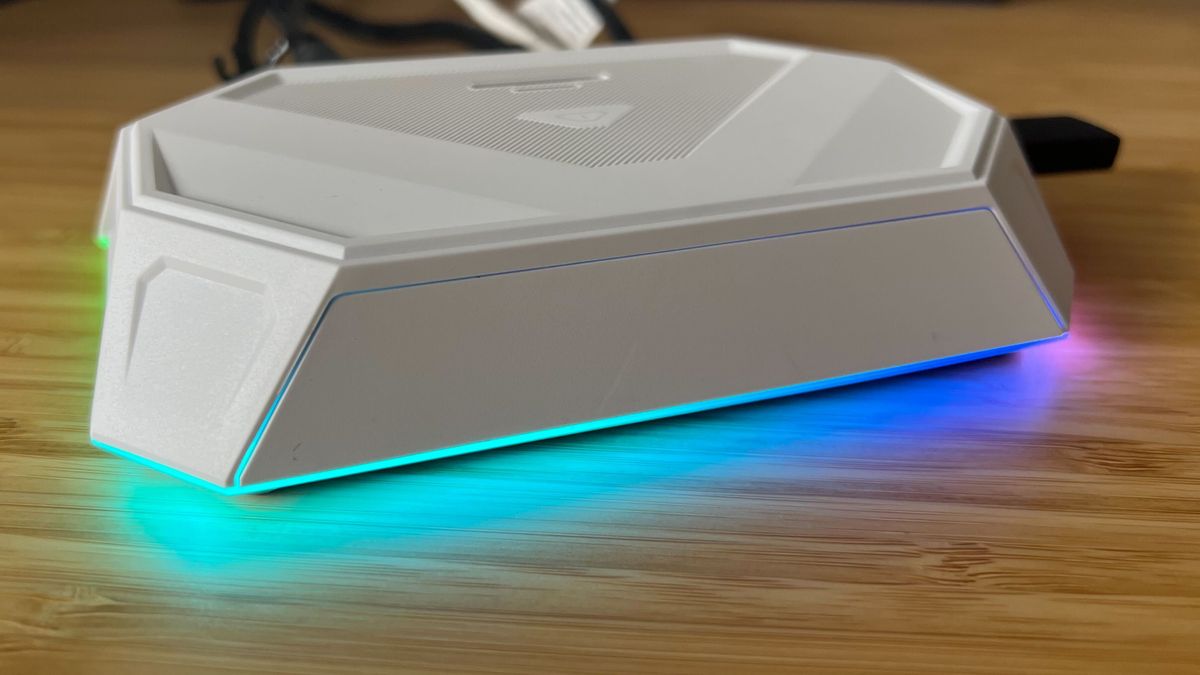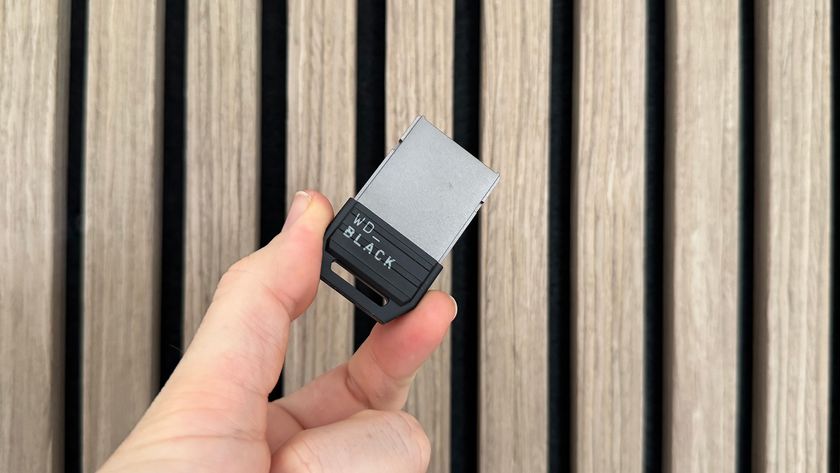12DOVE Verdict
The JSAUX RGB Docking Station does exactly what it says on the tin, but low quality build materials could put you off this luxuriously priced peripheral.
Pros
- +
More ports than you'll usually find in a handheld dock
- +
Crisp, clean aesthetic
- +
Incredibly vibrant RGB lighting
- +
Speedy connections
- +
Easy setup with minimal fuss
Cons
- -
Lower quality build for the price
- -
Expensive compared to the competition
- -
Stand tray needs more padding
Why you can trust 12DOVE
It's difficult to ramble about handheld PC docks for too long. These are often simple black boxes with between three and twelve ports fixed to the side, designed to fade into the background until you hook up your Steam Deck or Asus ROG Ally. Jsaux is tired of living in the shadows, emerging from some dusty corner behind your monitor with its RGB Docking Station ready to take center stage. Those glaring RGBs won't be for those after the best Steam Deck dock for a low profile setup, but this one's for the LED lovers among us.
| Video output | 1x HDMI 4K 120Hz | 1x DisplayPort 4K 120Hz |
| Ports | 1x USB-A 2.0 (480Mbps) | 2x USB-A 3.2 (10Gbps) | 1x USB-C 3.2 (10Gbps) | RJ45 | USB-C 100W power delivery | USB-C in | SD / TF card reader (480Mbps) | 1x 3.5mm audio |
| Ethernet | 1,000Mbps |
| Power delivery | 100W |
Design

The JSAUX RGB Docking Station certainly doesn't look like any other dock out there, even aside from the vibrant colors running around the bottom. The flat oblong shape is softened by paneled corners and indentations that feel more like a Sci-Fi launch pad than a place to keep all your cables connected. It's a neat look with a crisp white paintjob that serves the Asus ROG Ally's aesthetic particularly well.
The build quality is lacking slightly considering the $89.99 price tag. This is a thinner plastic shell which means it feels and sounds hollow in the hands and doesn't carry that air of premium luxury you might expect from nearly $100. I'm not too concerned about the long term durability of this shell, especially seeing as it's been designed to sit on your desk and stay there. However, considering the majority of docks at this price point send you home with some brushed metal or aluminum it's disappointing to feel short changed here.
Where JSAUX biffs it with the build quality, though, they certainly turn up with the LEDs. This is incredibly vibrant and nicely defined RGB lighting, showing off some pretty extreme brightness and casting a powerful glow on the desk below at the same time. You can also adjust colors and patterns using OpenRGB running from Steam on your device as well. If you happen to be running the Asus ROG Ally, it's worth keeping those thumbstick lights on for an even more impressive effect.
Features
The JSAUX RGB Docking Station is generous with its connections, at least in the 12-port model I received. Three USB-As (one limited to 480Mbps and the other two running at 10Gbps) meant I was able to easily keep a keyboard, mouse, and headset connected to the dock at all times. Meanwhile, the USB-C 3.2 handled my webcam day to day. I primarily used the HDMI connection to hook up to my Samsung Odyssey gaming monitor, but was also able to test a 4K connection using a separate TV setup. Both options ran smoothly from the Docking Station, though I did have to switch out my HDMI cable to something a little more premium for everything to hit right on the larger screen.


JSAUX also includes a separate DisplayPort option, which means the dock can technically output to two displays at 4K. It's difficult to see where one might be using two different connection methods on two different monitors, but the option is there even if you might need an adapter or new cable to fully take advantage of it.
You'll also find slots for a SD and TF cards (though both can't be used at the same time), as well as an Ethernet and 3.5mm out for wired headsets and speakers.
The dock can pass through 100W power, though some is obviously consumed by the dock itself and does depend on the quality of the power cable you're using from the wall. I wasn't able to draw enough power for the Ally's full 30W Turbo Mode through the device, tapping out at 25W even with the original Asus charger plugged in. You'll need a full 100W adapter (the Ally taps out at 65W) to turn things up to 11.
The only other feature of note is so hidden I nearly missed it. JSAUX doesn't do a great job of signposting certain elements of its device, adding a 'Push' sticker to the front panel that I all but ignored after dutifully doing so and watching the little panel simply pop out slightly. Once I realized I had to pull it out after that, it dawned on me that this is actually a stand for the handheld itself. It's a nice addition that gets a one up over other docks that require separate solutions, but it's somewhat janky in its implementation.
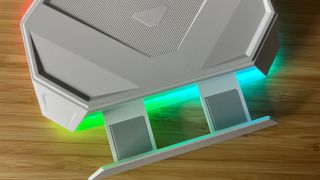
Pulling the stand out is scratchy and a little concerning considering just how thin this plastic is. The padding offered at the bottom of the tray is also barebones, consisting of a simple piece of tacky rubber nestled in two cradling pieces of plastic. Considering this is going to be home to some of the best gaming handhelds on the market, I would consider throwing a buffer on your device before regularly pulling it in and out of here.
Performance

The best thing you can say about a handheld dock is that it just works - and the JSAUX RGB Docking Station just works. I was able to transfer all my cables from the Ugreen model I've been using, sling some power in, and I was good to go. Resolution snapped straight to my QHD monitor in the perfect aspect ratio with no further tinkering required. Not only that, but everything ran nice and slick with no noticeable input delay from peripherals.
Transfer speeds were slick as well, though not quite as fast as a more creative professional oriented device. Still, I managed to offload plenty of gameplay recordings from the Ally onto a separate stick at about the same rate I would expect from a high-end laptop. The reverse was true as well, moving video files from my PS5 to the Ally using the same method proved speedy and effective.
Should you buy the JSAUX RGB Docking Station?
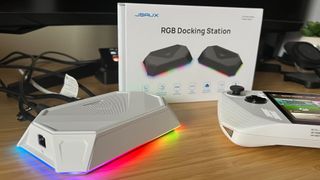
If you can get past the sub-par build quality, the JSAUX RGB Docking Station is a solid pick for anyone looking for a little more RGB in their setup. You won't find lights quite like this on another device, save for the $300 Razer Thunderbolt 4 Chroma Dock. It's not, however, a must-have - especially at $89.99. $30 can get you a solid dock - it's the going rate of our favorite device, the Baseus 6-in-1. Now, you are dropping to slightly slower ports and there's no DisplayPort option for dual-screen action - but if you're just looking to play from your desk every now and then it's really all you need.
I have preferred having the extra six ports to play with, though, especially in a productivity setting. Having connected both my laptop and Ally to all my peripherals in the last few weeks, I can say that the all-in-one nature of the JSAUX is certainly worth investigating. There aren't too many 12 port options also catering to handheld devices with dedicated stands on the market right now, so if you're after a work / hybrid device then this could be a worthy contender. Just remember to switch off those LEDs when you're in a meeting.
How we tested the JSAUX RGB Docking Station
I used the JSAUX RGB Docking Station as my only dock for both work and play over a period of one month. I had it connected between a Razer Blade 14 gaming laptop and Samsung Odyssey G5 gaming monitor for both work and play, while also swapping over to the Asus ROG Ally for docked sessions as well. In that time, I tested across Fallout 4, We Happy Few, New Super Lucky Tales, and Assassin's Creed Odyssey. For more information on how we make our recommendations, check out the full 12DOVE Hardware Policy.
If you're rounding out your setup, check out the best HDMI cables available - or for something a little more exciting, take a look at the best PC controllers and the best Steam Deck headsets.

Managing Editor of Hardware at 12DOVE, I originally landed in hardware at our sister site TechRadar before moving over to GamesRadar. In between, I've written for Tom’s Guide, Wireframe, The Indie Game Website and That Video Game Blog, covering everything from the PS5 launch to the Apple Pencil. Now, i'm focused on Nintendo Switch, gaming laptops (and the keyboards, headsets and mice that come with them), PS5, and trying to find the perfect projector.

New Elden Ring Nightreign trailer is all about the archer class that wasn't in the beta, and this might be the first FromSoftware game where bows don't suck

Pokemon Platinum's most obscure feature was a reward seemingly given to just 20 players lucky enough to participate in a complicated limited-time event with a lottery prize
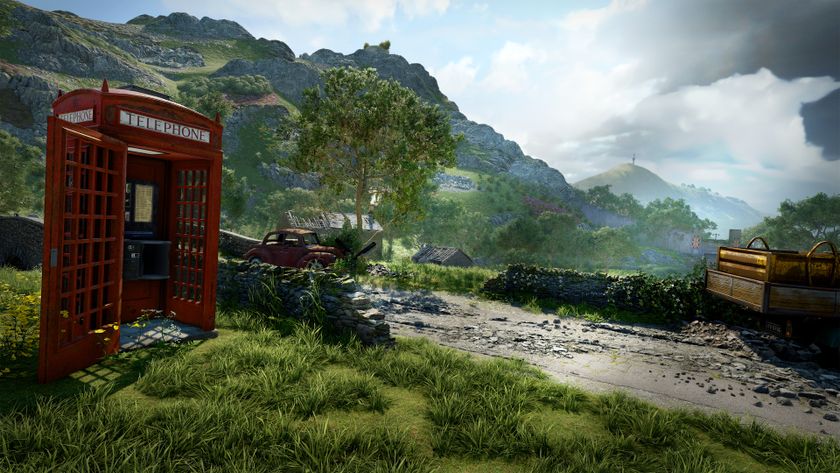
Atomfall officially reaches “extremely British” status as the survival game surpasses 1.5 million players, who’ve collectively sipped 300,000 cups of tea and executed 3.7 million kills with a cricket bat
